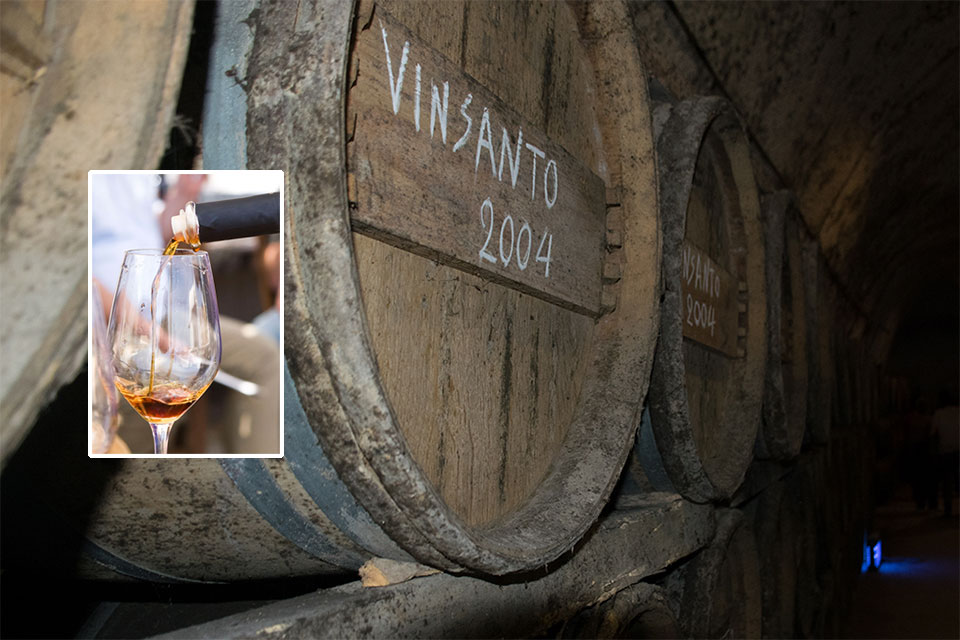Santorini island news
Vinsanto – The naturally sweet wine of Santorini
Vinsanto is Santorini’s famous, naturally sweet, sun-dried dessert wine. Even though it is red in color, it is produced from overripe white grapes. The grapes are spread and left to dry for several (6-8) days under the hot sun of Santorini. This process gives a concentrated, sweet, golden wine with an explosive aroma of raisins, dried figs, honey, nuts and coffee. The Vinsanto wine matures for years in oak barrels and then matures even longer in the bottle.
It belongs to the category of wines of Protected Designation of Origin – PDO Santorini. According to the legislation, it must come from grapes of the Assyrtiko variety by at least 51% and the rest it should come from Athiri, Aidani and small quantities of white “xenoloa” (xenos=foreigner, grape varieties that were brought to Santorini from other lands), cultivated traditionally in the complex of Santorini, Thira and Thirasia, and specifically of the varieties Gaidouria, Katsano, Moschato white, Monemvasia, Platani, Potamisi and the reddish variety Roditis.
The Santorini Vinsanto is one of the very few sweet wines in the world that is produced without added sugar (or the use of artificial methods). Its natural sugar is formed during the time that the grapes are sun-dried. The exact opposite method is used for the production of the Ice Wine wine (Eiswein) which is produced mainly in Canada. In the years that are heavy in snow, the grapes are harvested and fermented while they are still frozen. There are also other, “artificial” ways to improve the sweetness of the wine. Examples would be to freeze the grapes in an artificial environment before squeezing the sugars (“cryoextraction”) and to concentrate the must of the grapes by removing their water (reverse osmosis) and to add sugar before or during fermentation (dry wine sugaring).
Almost all of the wineries of Santorini produce their own Vinsanto. Each Vinsanto is very different than the other due to different percentages in the grape varieties. What really distinguishes some Vinsanto wines though, is their ageing, that has taken place in barrels before bottling. Choosing which winery or date your bottle would be can be tricky. The end result is different every year. Some general directions are that typically the older it is the better it will taste, while the barrel itself also plays its role. Some years have also produced better Vinsantos than others, for example the 2013 vintage has been a very good year in terms of grape quality, something you can taste in the wine.
There are many reasons to purchase a Vinsanto, either for a friend or yourself, with a round, velvet and rich texture in taste. It is a great alternative to a dessert or as an aperitif. It is especially well paired with chocolate or cheese, or you can enjoy it with light desserts made of cream, dried nuts or sweet spices. The most important factor though is that even when opened, it can be kept for a very long time to be consumed later on as long as you keep it in the fridge. If you can stop yourself from drinking it all at once! Best served at 12oC.
We have gathered below all the Vinsanto labels of Santorini, available for purchase (alphabetically), which ones have you tried?
Argyros Vinsanto – 4 years old
Argyros Vinsanto – 12 years old
Argyros Vinsanto – 20 years old
Artemis Karamolegos Vinsanto 2008
Canava Roussos Vinsanto
Gavalas Vinsanto
Hatzidakis Vinsanto 2004
Kasteli Vinsanto
Koutsogiannopoulos Vinsanto
Santowines Vinsanto – 12 years old
Santowines Vinsanto 2004
Santowines Vinsanto 2012
Santowines Vinsanto 2013
Sigalas Vinsanto 2013
Venetsanos Vinsanto 2016

